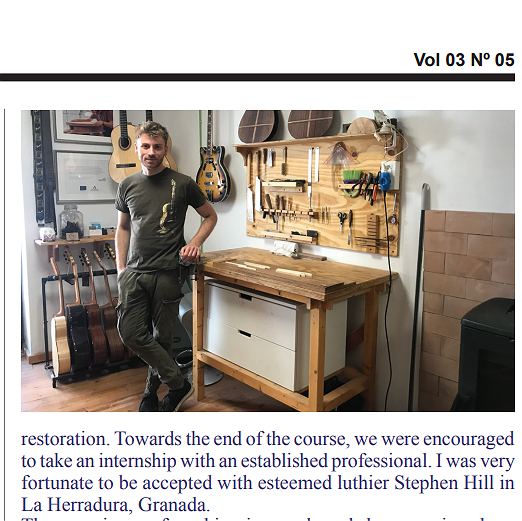Entrevista en Gazette Costa tropical y Valle de Lecrín
A noble craft like carpentry would be a fine thing to practise. Transforming a piece of wood into something beautiful and useful sounds very wholesome. It was good enough for Jesus, it would be good enough for most; however, it isn’t enough for some folk. People like the Belgian born Johannes T’kindt (27), whose combination of a keen eye, a steady hand, a good ear and a creative flare, has led him to find his niche in lutherie. Recently he was kind enough to answer a few questions for this month’s edition of People in Motion. So, Johannes, what do you do and how did you get started?
So, Johannes, what do you do and how did you get started?
I restore, repair and make plucked instruments, with the majority of my time focused on creating classical and flamenco guitars. I guess I’ve always been fascinated by any kind of wooden construction. Building treehouses and go-carts as a kid were amongst the first things: then at 14 I decided to study woodworking at school, but it didn’t really do it for me, as it was all very industry-orientated. By the end of the first academic year, I started wondering where to go from there and looking for alternative wood related education; As I’d been playing the guitar from an early age and was interested in instruments, lutherie felt like a natural step. When I was 16, I went to study at the International Lutherie School of Antwerp (ILSA). For four years I learnt a lot about Spanish guitar-making and restoration. Towards the end of the course, we were encouraged to take an internship with an established professional. I was very fortunate to be accepted with esteemed luthier Stephen Hill in La Herradura, Granada. The experience of working in a real workshop convinced me to try my luck at opening my own. The only place I considered going was the province of Granada, not only because I had felt I found my place while working in La Herradura, but also because I was intrigued by Granada’s guitar-making traditions. Consequently, I dedicated myself to working towards starting my own shop. At 21 this was realised, when I opened a small space in Dúrcal. A year and a half later I moved to Nigüelas, where I still am today.
When you began building guitars, what did you take to easily and what challenges did you face?
Thankfully, I had a bit of experience in woodworking which played to my advantage. In the early stages, I enjoyed shapingthe neck and heel but I had a hard time with the finer techniques like making the rosettes. Honestly, I also lacked a bit of patience which is something that I’ve learnt to overcome.
What and who motivates you to continue developing and mastering your craft?
’m dedicated to improving my instruments and techniques with each and every one I make. As the years go by, the maestros and their instruments intrigue me more and more. While at first, I had some wildly ambitious ideas of how I could revolutionise the guitar and find ‘the new sound', I’m now focused on developing a profound understanding of construction. Of course, fellow guitar-makers, friends and colleagues undoubtedly inspire me to try new techniques, different timbers and to keep it up.
Whether it’s flamenco or classical guitars, how do you choose wood? What are you looking for?
very component of the guitar requires a specific type of timber. The soundboard for example needs a light and soft timber to be as resonant as possible; spruce or red cedar are the main two species we use. When selecting soundboards I look for stiff and perfectly quarter-sawn pieces with a fine, straight, regular grain. For the neck, Mediterranean cedar or mahogany are decent options. It's important for me to try out different, locally sourced and more sustainable timbers like pear, cherry, walnut and cypress when it comes to the back and sides, but I also use rosewood and other exotic timbers.
Southern Spain has long been considered the birth place of the guitar. How much do geographical or historical aspects of this area have an effect on the work you produce?
My work is heavily influenced by the Granada school of guitar-makers. Although I give my instruments a personal touch and use techniques I learned from different places, they are always built with the utmost respect to the traditional Spanish classical guitar. What advice would you give to someone who would like to explore the artisan craft of instrument making? Study under a master, be thirsty for knowledge, keep an open mind, be humble and patient. Simple.
How can people best support and follow you other than just buying a guitar?
Obviously the very best way to support me is to buy one of my guitars. Apart from guitars I also make cajons and artisan capos. In the workshop I also have a modest assortment of guitar accessories such as strings, tuners, footstools, guitar stands and the rest. Feel free to stop by and say hello, follow me on social media (@johannes_kindt_luthier) and check out the website (johannestkindt.com) where you can see all that’s going on. Many thanks to Johannes for this interview. I hope, like me, you’ve learnt a couple of things.


